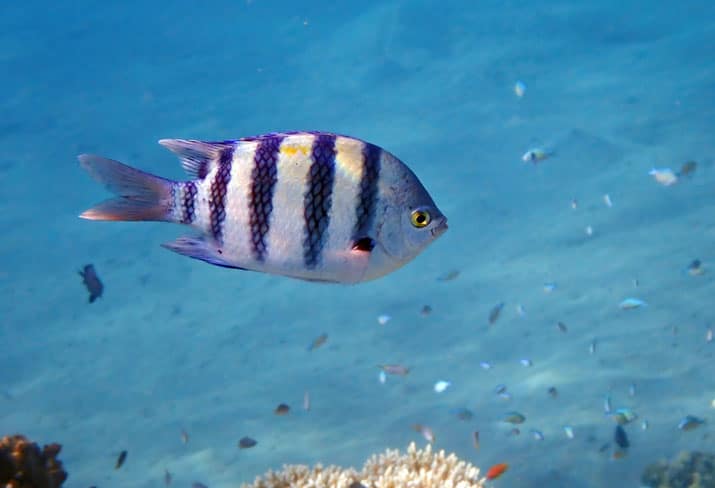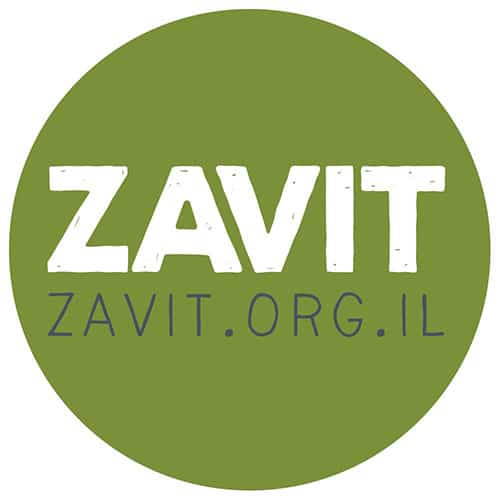 Close-up of Sergeant major, which inhabits shallow waters of the Red Sea.
Close-up of Sergeant major, which inhabits shallow waters of the Red Sea. Whenever you visit the beach and enter the water to swim around and have fun, how often are you aware of the small community of fish that also occupy the water around your legs? Because of plentiful recreational distractions, shallow water fish usually go unnoticed most of the time. But does our intrusive presence in their habitat harmfully disrupt their distribution, or does our presence yield neutral consequences?
Seeing as how it is impossible to discern what a fish thinks and feels exactly, observing their behavior is the next best way to understanding their relationship with their surroundings, which includes us, or lack thereof.
According to an Israeli study conducted in the Gulf of Eilat, many species took the opportunity to expand their habitat range to new areas during the months in which we were ordered to stay confined to our homes during the COVID-19 lockdown periods. With lockdown protocols in effect, human presence in public recreational areas, including beaches, were reduced to near zero, enabling animals the chance to occupy those spaces we would routinely crowd.
Fishing for Answers
Published in the scientific journal Biological Conservation, the study was conducted by researchers from Ben Gurion University in collaboration with Prof. Yoni Belmaker of the Steinhardt Museum of Nature at Tel Aviv University and Eilat Bay ecologist Dr. Assaf Zvuloni of the Nature and Parks Authority.
The researchers examined the behavior of the fish that live in the southern coast of Eilat’s coral reefs, which are considered to be one of Israel’s most popular tourist attractions. The sampled area is within a marine nature reserve, where access to the sea is allowed from a number of marked entrances only. The study was conducted before, during, and after the second mandated closure in mid-October 2020.
In order to properly monitor the fish and track their hypothesized behavioral change, the researchers had to place cameras underwater. But to generate accurate test results, they placed the cameras in different areas that received different ranges of public presence.
“The cameras were deployed in three different areas along the south coast,” says Dr. Victor Kina of the Institute for Desert Research at the Sde Boker Campus of Ben-Gurion University and the Inter-University Institute of Marine Sciences in Eilat. “The area where bathers are allowed to enter the water; the adjacent area near the water entry section where bathers are typically not present, and the coral area, which is 3-6 meters deep and is only occasionally reached by divers and therefore receives less human disturbance.”
Fewer People, More Fish
According to the study’s findings, fish species appeared in the areas that bathers usually occupied during the city-wide lockdown, and some of the species that were observed were those that are normally not present at all. Among the fish that appeared were carnivorous species, which swim in the open sea and come to the reef in search of something to eat.
“Apparently, these fish were pushed aside and did not enter because of human disturbances,” says Dr. Kina. “Human disturbance simply pushes them to other areas.”
However, it should be noted that the phenomenon was not observed in the adjacent areas to the main water entry and in the entry areas primarily used by divers.
“Any kind of disturbance from the divers is probably more minor, so it is insignificant for the fish population,” says Dr. Kina.
Aside from the increases in fish abundancy within the once-occupied public waterfront, the researchers witnessed another interesting phenomenon develop in that same area that significantly altered the typical diversity index of the Gulf of Eilat’s ecosystem. The index always ranges from 0 to 1 where values close to 1 represents an ecological community in which all species occur in equal numbers. When values near 0, it means that the community is dominated by one or just a few dominant species. During Israel’s second lockdown, an increase in fish diversity was observed in the public beach area.
“This can be explained simply by the fact that more cowardly species dared to swim in these areas where they are less commonly found since humans were not there,” says Dr. Kina.
The researchers’ next steps will involve investigating the long-term impacts human interaction has on the fish’s environment such as examining whether human presence affects the health and physiological state of fish and their diet.
Wildlife Reclamation?
Does this phenomenon sound familiar to you? If so, then you remember when the media covered quite a few stories about wildlife “taking over” our cities and towns when the streets were nearly devoid of people at the height of the initial waves of the COVID-19 crisis.
Deer were reported roaming the public gardens in Jerusalem, ibexes strolled on the promenade in Eilat, ducks enjoyed the streets of Paris, wild boars descended on Barcelona from the peaks surrounding the city, and wild turkeys flocked California in droves. So, it would seem the fish from the Gulf of Eilat are not the only animals that ventured into new areas during the lockdowns.
Various studies have examined whether the popular utopian claim about wildlife reclaiming the urban environment has a basis beyond the anecdotes put forth by the press. While some indicate that COVID-related shutdowns alleviated pressure on some mammalian species allowing them to expand their range, other studies conclude that we humans just became more aware of the nature that regularly surrounds us due to the fact that we were confined to our homes.
Minimize Your Impacts
The findings of the new study illustrate the importance of restricting access to water in the coral reserve areas, which would include the nearby area adjacent to the climate-resilient coral reef reserve in the Gulf of Eilat.
“This policy has proven to be very effective along the southern coast of the Gulf of Eilat,” says Dr. Kina. “People only enter a very small part of the total area available for fish when they get into the water, which minimizes the harm to species diversity of species, and allows for a good balance between recreation and tending to the needs of the animals.”
In any case, until we know more about the significance of human coastal activity on the shores, it is worth remembering that the communities of fish also need this space to live their lives between the waves.
ZAVIT – Science and the Environment News Agency























 More news and opinions than at a Shabbat dinner, right in your inbox.
More news and opinions than at a Shabbat dinner, right in your inbox.